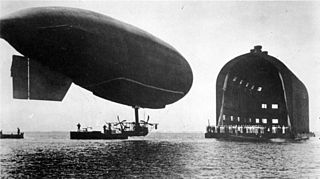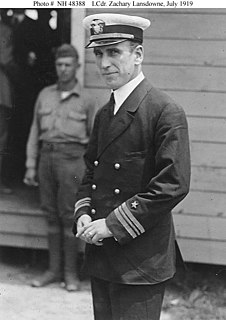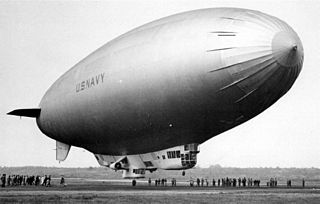 W
WThe American Blimp MZ-3A is a blimp owned by the United States Navy from 2006 to 2017. It is a modified American Blimp Corporation A-170 series commercial blimp and given the USN type/model/series (T/M/S) designation MZ-3A and Bureau Number (BuNo) 167811. After delivery to the Navy, the airship began operations as an advanced flying laboratory used to evaluate affordable sensor payloads, the development of new lighter-than-air (LTA) technologies and general flight support for other related research and development/science and technology (R&D/S&T) projects. It was the last airship to be operated by the U. S. military.
 W
WThe B class blimps were patrol airships operated by the United States Navy during and shortly after World War I. The Navy had learned a great deal from the DN-1 fiasco. The result was the very successful B-type airships. Dr. Jerome Hunsaker was asked to develop a theory of airship design, Lt. John H. Towers had returned from Europe having inspected British designs, and using reports from attachés on British airship operations, the Navy was prepared to seek bids for blimps from American manufacturers. On 4 February 1917 the Secretary of the Navy directed that 16 nonrigid airships of Class B be procured. A February 12, 1917 meeting with the Chief of the Bureau of Construction and Repair, and representatives of Goodyear, Goodrich, Connecticut Aircraft Company, Curtiss Aeroplane and Motor Corporation, and U.S. Rubber Company, it was agreed that the order for 16 dirigibles was beyond the capability of any one company. The conference resulted in a committee to coordinate on sharing raw materials, information and experience. Ultimately Goodyear manufactured 9 envelopes, Goodrich made 5 and Curtiss assembled the gondolas for all of those 14 ships. Connecticut Aircraft contracted with U.S. Rubber for its two envelopes and with Pigeon Fraser for its gondolas. The Curtiss-built gondolas used by Goodyear and Goodrich used modified Curtiss JN-4 fuselages powered by Curtiss OXX engines. The Connecticut Aircraft blimps were powered by Hall-Scott engines. One ship, B-20 was equipped with a special control car. All B-Class airships were delivered to the Navy between August 1917 (B-1) and September 1918 (B-20).
 W
WDuring the First World War, the US Navy trained crews at British bases, and operated British designed and built blimps on combat patrols. The Navy purchased three types of British blimps. Operations were flown in a US SSZ and airships operated by the Royal Navy.
 W
WC-5 was a hydrogen inflated C class blimp operated by the U.S. Navy in 1918 and 1919. It was one of ten C class non-rigid airships built by Goodyear and Goodrich primarily for training and patrol duty for the navy during World War I.
 W
WThe C-class blimp was a patrol airship developed by the US Navy shortly after World War I, a systematic improvement upon the B-type which was very suitable for training, but of limited value for patrol work. Larger than the B-class, these blimps had two motors and a longer endurance. Once again, the envelope production was split between Goodyear and Goodrich, with control cars being built by the Burgess division of Curtiss Aeroplane and Motor Company. Originally the Navy ordered 30 but reduced the number to 10 after the armistice in November 1918. All ten of the "C" type airships were delivered in late 1918, and examples served at all of the Navy's airship stations from 1918 to 1922. In 1921 the C-7 was the first airship ever to be inflated with helium. The Navy decommissioned its last two remaining C-type blimps, the C-7 and C-9 in 1922.
 W
WThe D class blimp was a patrol airship used by the US Navy in the early 1920s. The D-type blimps were slightly larger than the C-type and had many detail improvements. The Navy continued the practice of dividing the envelope production between Goodyear and Goodrich. The control cars were manufactured by the Naval Aircraft Factory. The major improvements over the C-type blimps were a better control car design and easier, more reliable controls and instrumentation. The engines were moved to the rear to reduce noise and allow better communications between crew members. The fuel tanks were suspended from the sides of the envelope. The envelope was identical to the C-type, except an additional six-foot panel was inserted for a total length of 198 feet (60 m) and a volume of 190,000 cubic feet (5,400 m3). The last of the D-Class, D-6, had a different control car designed by Leroy Grumman who later founded the Grumman Aircraft Engineering Corporation.
 W
WThe DN-1 was the US Navy's first airship. Captain Mark L. Bristol, the second Director of Naval Aviation, supported the development of the dirigible in the anti-submarine role. Victor Herbster, Holden Richardson and LCDR Frank McCrary drew up the specifications for the DN-1. The contract was awarded on 1 June 1915 to the Connecticut Aircraft Company of New Haven, CT. The U.S. Navy had no experience with airships and it seems neither had any of the principals of Connecticut Aircraft Company. They were a lawyer who was the financial backer, an amusement park owner who acted as manager; the technical staff was an Austrian, Hans Otto Stagel, who claimed to be a dirigible pilot and a German engineer and mechanic, who claimed to be Zeppelin experts. Jerome Clarke Hunsaker of MIT and his assistant Donald Wills Douglas, later founder of the Douglas Aircraft Company, aided the Connecticut Aircraft Company in the design of DN-1. The Chief Engineer was James F. Boyle and the Production Manager was J.J. DeLunay. The civilian inspector was Thomas Scott Baldwin and the resident Navy inspector was Frank M. McCrary.
 W
WThe E class of US Navy blimps comprised a single airship, built during World War I by Goodyear as one of a group of three small blimps offered to the US government. Two were purchased for the US Navy and one for the US Army. The Navy blimps were designated E-1, F-1, and the Army airship A-1. These airships had identical envelopes but different cars. The E-1 was delivered to Pensacola, Florida in December 1918. It was flown only at Pensacola serving as a trainer at the Airship School. A new envelope was provided in December 1920. E-1 was retired from service sometime in 1924.
 W
WThe F class of US Navy blimps comprised a single airship, built during World War I by Goodyear as one of a group of three small blimps offered to the US government. Two were purchased for the US Navy and one for the US Army. The Navy blimps were designated E-1, F-1, and the Army airship A-1. Classified as an "Experimental Engine Testing Dirigible." F-1 had the same envelope size as the E-1, due to the use of a tractor mounted 125 hp Union engine, the performance was different. F-1 spent its entire career at Hampton Roads. It was flown in both tractor and pusher configurations. It also may have been flown with a Curtiss OXX engine. F-1 was removed from inventory in November 1923.
 W
WThe G-Class Blimps were a series of non-rigid airships (blimps) used by the United States Navy. In 1935, instead of developing a new design airship, the Navy purchased the Goodyear Blimp Defender for use as a trainer and utility airship assigning it the designator G-1. Defender was built by the Goodyear Aircraft Company of Akron, Ohio and was the largest blimp in the company’s fleet of airships that were used for advertising and as passenger airships. Goodyear built additional G-class airships for the Navy during World War II to support training needs.
 W
WThe H class blimp was an observation airship built for the U.S. Navy in the early 1920s. The original "H" Class design of 1919 was for a twin engined airship of approximately 80,000 cubic feet volume. Commander Lewis Maxfield suggested that a small airship which could be used either as a tethered kite balloon, or be towed by a ship until releasing its cable, would be able to scout on its own. The concept was an airship similar to the later Army Motorized Kite Balloons.
 W
WThe J-class blimps were non-rigid airships designed by the Navy Bureau of Aeronautics and Goodyear Tire & Rubber Company in the early 1920s for the US Navy.
 W
WThe K-class blimp was a class of blimps built by the Goodyear Aircraft Company of Akron, Ohio for the United States Navy. These blimps were powered by two Pratt & Whitney Wasp nine-cylinder radial air-cooled engines, each mounted on twin-strut outriggers, one per side of the control car that hung under the envelope. Before and during World War II, 134 K-class blimps were built and configured for patrol and anti-submarine warfare operations, and were extensively used in the Navy’s anti-submarine efforts in the Atlantic and Pacific Ocean areas.
 W
WThe L class blimps were training airships operated by the United States Navy during World War II. In the mid-1930s, the Goodyear Aircraft Company built a family of small non-rigid airships that the company used for advertising the Goodyear name. In 1937 the United States Navy awarded a contract for two different airships, K class blimp designated K-2 and a smaller blimp based upon Goodyear's smaller commercial model airship used for advertising and passenger carrying. The smaller blimp was designated by the Navy as L-1 The L-1 was delivered in April 1938 and operated from the Navy's lighter-than-air facility at Lakehurst, New Jersey. In the meantime, the Navy ordered two more L-Class blimps, the L-2 and L-3, on September 25, 1940. These were delivered in 1941. L-2 was lost in a nighttime mid-air collision with the G-1 on June 8, 1942.
 W
WLieutenant Commander Zachary Lansdowne, USN was a United States Navy officer and early Naval aviator who contributed to the development of the Navy's first lighter-than-air craft. He earned the Navy Cross for his participation in the first transoceanic airship flight while assigned to the British R34 in 1919. He later commanded the USS Shenandoah (ZR-1), which was the first rigid airship to complete a flight across North America. He was killed in the crash of the Shenandoah.
 W
WThe Goodyear Aircraft Company of Akron, Ohio built the M-class blimp for the US Navy as the follow-on to the K-class anti-submarine warfare blimp used during World War II. It was a significantly larger airship, 50% larger than its predecessor. Four airships, designated M-1 through M-4, were delivered in early 1944. Operations of K-ships in tropical regions had shown a need for a blimp with greater volume to offset the loss of lift due to high ambient temperatures.
 W
WThe N-Class, or as popularly known, the "Nan ship", was a line of non-rigid airships built by the Goodyear Aircraft Company of Akron, Ohio for the US Navy. This line of airships was developed through many versions and assigned various designators as the airship designation system changed in the post World War II era. These versions included airships configured for both anti-submarine warfare and airborne early warning (AEW) missions.
 W
WNaval Air Station South Weymouth, was an operational United States Navy airfield from 1942 to 1997 in South Weymouth, Massachusetts. It was first established as a regular Navy blimp base during World War II. During the postwar era the base became part of the Naval Air Reserve Training Command, hosting a variety of Navy and Marine Corps reserve aircraft squadrons and other types of reserve units. Like most BRAC sites, environmental contamination was detected in 1986, and since 1993 numerous remedies and long term monitoring of ground water are in place. Since 2005, over 600 acres have been transferred to the affected towns for reuse, and in 2011 the Navy signed a $25 million contract to transfer its remaining land.
 W
WThe ZMC-2 was the only successfully operated metal-skinned airship ever built. Constructed at Naval Air Station Grosse Ile by The Aircraft Development Corporation of Detroit, the ZMC-2 was operated by the U.S. Navy at Lakehurst, New Jersey from 1929 until its scrapping in 1941. While at Lakehurst it completed 752 flights, and logged 2265 hours of flight time.